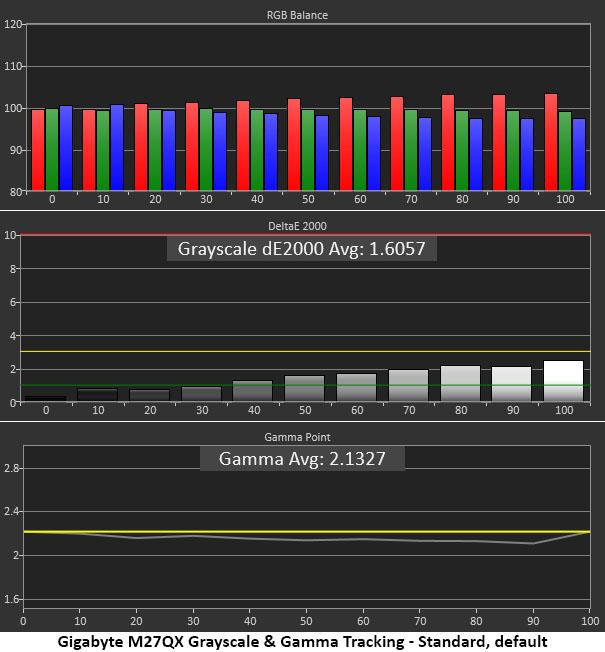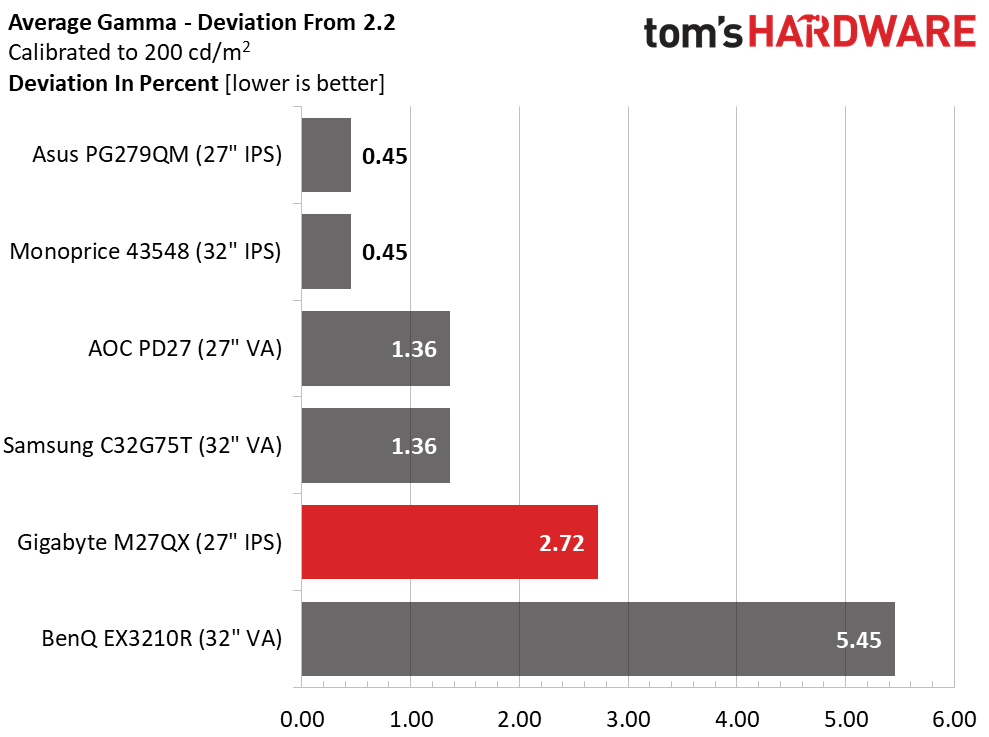Why you can trust Tom's Hardware
In the M27Q X’s Standard picture mode, grayscale, gamma and color are close enough to perfect that calibration is not required. The native gamut is large on the blue and green side of the triangle, and red is slightly under-saturated. But overall accuracy is quite high.
Grayscale and Gamma Tracking
Our grayscale and gamma tests use Calman calibration software from Portrait Displays. We describe our grayscale and gamma tests in detail here.



Out of the box, the M27Q X’s white point looks a tad red on the chart, but the errors are below the visible threshold. Calibration is unnecessary. Gamma is the tiniest bit light, but that error is also invisible.
With calibration, grayscale tracking is about as good as is possible. The M27Q X posts one of the best calibrated grayscale results I’ve ever recorded. Gamma is unchanged.
If you need an accurate sRGB mode, the M27Q X provides one. It locks out all adjustments except brightness but that’s OK because it’s nearly flawless. The only error is a dip in gamma at 10 and 20%. This is excellent performance.
Comparisons




With an out-of-box grayscale error of 1.61dE, the M27Q X is ready to go with an accurate image. The 0.28dE result I achieved after calibration is the second-lowest score I’ve recorded of the 292 monitors I’ve reviewed since 2013, impressive! Only the Asus VG259QM was lower with 0.24dE.
Gamma tracks well regardless of color mode. A 0.08 range of values is excellent, and the deviation from 2.2 is only 2.72%. This means all detail present in the original signal will be clearly and accurately rendered.
Get Tom's Hardware's best news and in-depth reviews, straight to your inbox.
Color Gamut Accuracy
Our color gamut and volume testing use Portrait Displays’ Calman software. For details on our color gamut testing and volume calculations, click here.



The M27Q X advertises a super wide gamut, and it is indeed large, but there’s a catch. Blue and green are over-saturated to compensate for an under-saturated red primary. On the chart, you can see this behavior. Red meets its targets up to 60%, but 80 and 100 are short of the mark for DCI-P3. This isn’t wholly bad as SDR content mastered in sRGB will benefit. In fact, the overall error is low, so I have no complaints. I noted that the M27Q exhibited this same response.
Calibration improves the slight hue error in magenta but doesn’t fix it entirely. The average color error only changes a little. The takeaway is that there is no problem here and calibration only makes a tiny and mostly invisible difference.
The sRGB mode has pro-level accuracy with every point inside or in contact with its target box. The box represents 1dE, so this mode is visually perfect.
Comparisons


A 2.14dE score puts the M27Q X mid-pack in a group of excellent screens. Only the Monoprice has any visible issues, and they are small. The other monitors have very accurate colors and will look about the same in a side-by-side comparison.
With 102.76% coverage of DCI-P3, there is plenty of color for both SDR and HDR content. The red under-saturation is more than compensated for by extra green and blue. Since only two targets are a little off the mark, the final presentation is a good one. The only downside is that the M27Q X is not a great choice for color-critical work in DCI-P3. A software profile can’t add in the missing red hues. sRGB would be fine though. For general use, color is vibrant and saturated.
Current page: Grayscale, Gamma and Color
Prev Page Brightness and Contrast Next Page HDR Performance
Christian Eberle is a Contributing Editor for Tom's Hardware US. He's a veteran reviewer of A/V equipment, specializing in monitors. Christian began his obsession with tech when he built his first PC in 1991, a 286 running DOS 3.0 at a blazing 12MHz. In 2006, he undertook training from the Imaging Science Foundation in video calibration and testing and thus started a passion for precise imaging that persists to this day. He is also a professional musician with a degree from the New England Conservatory as a classical bassoonist which he used to good effect as a performer with the West Point Army Band from 1987 to 2013. He enjoys watching movies and listening to high-end audio in his custom-built home theater and can be seen riding trails near his home on a race-ready ICE VTX recumbent trike. Christian enjoys the endless summer in Florida where he lives with his wife and Chihuahua and plays with orchestras around the state.